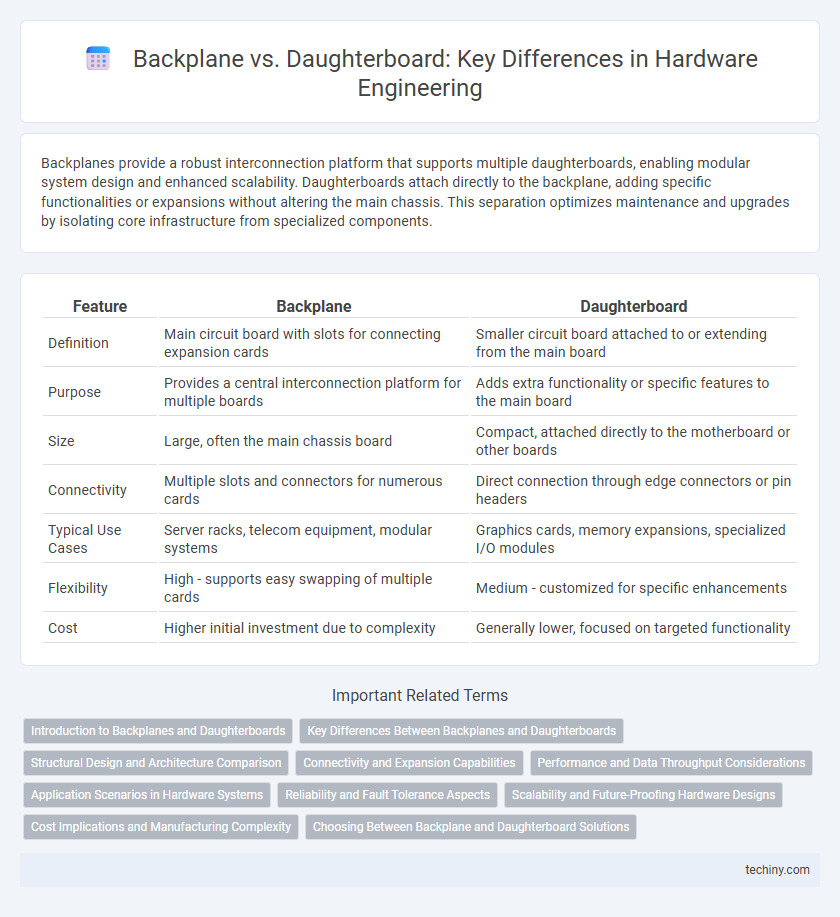Backplanes provide a robust interconnection platform that supports multiple daughterboards, enabling modular system design and enhanced scalability. Daughterboards attach directly to the backplane, adding specific functionalities or expansions without altering the main chassis. This separation optimizes maintenance and upgrades by isolating core infrastructure from specialized components.
Table of Comparison
| Feature | Backplane | Daughterboard |
|---|---|---|
| Definition | Main circuit board with slots for connecting expansion cards | Smaller circuit board attached to or extending from the main board |
| Purpose | Provides a central interconnection platform for multiple boards | Adds extra functionality or specific features to the main board |
| Size | Large, often the main chassis board | Compact, attached directly to the motherboard or other boards |
| Connectivity | Multiple slots and connectors for numerous cards | Direct connection through edge connectors or pin headers |
| Typical Use Cases | Server racks, telecom equipment, modular systems | Graphics cards, memory expansions, specialized I/O modules |
| Flexibility | High - supports easy swapping of multiple cards | Medium - customized for specific enhancements |
| Cost | Higher initial investment due to complexity | Generally lower, focused on targeted functionality |
Introduction to Backplanes and Daughterboards
Backplanes are circuit boards serving as a common backbone to connect multiple daughterboards, enabling communication and power distribution within hardware systems. Daughterboards are smaller, specialized circuit boards that plug into backplanes to expand system capabilities by adding specific functions or features. Both components are essential in modular hardware engineering, allowing flexible customization and scalability in electronic systems.
Key Differences Between Backplanes and Daughterboards
Backplanes serve as the main circuit board, providing a foundational platform with slots for connecting multiple daughterboards, whereas daughterboards are smaller circuit boards that plug into backplanes to extend functionality and add specific features. Backplanes primarily handle power distribution and inter-component communication, while daughterboards focus on specific processing tasks or interface enhancements. The modular design of backplanes allows for scalability and easy replacement of daughterboards, optimizing system customization and maintenance in hardware engineering.
Structural Design and Architecture Comparison
Backplanes feature a rigid, fixed bus structure designed to support multiple plug-in cards, enabling robust communication and power distribution across the system. Daughterboards are compact, modular circuit boards attached perpendicularly or parallel to the mainboard, allowing flexible expansion and specialized functionality within limited space. The structural design of backplanes emphasizes durability and high-density interconnects, while daughterboards prioritize adaptability and targeted signal routing.
Connectivity and Expansion Capabilities
Backplanes provide a robust and scalable platform with multiple slots, enabling high-density connectivity for numerous modules and facilitating straightforward system expansion. Daughterboards offer targeted functionality enhancements by connecting directly to the main board, optimizing space and enabling specific feature upgrades without extensive reconfiguration. The choice between backplane and daughterboard hinges on the need for modular scalability versus compact, specialized extension in hardware design.
Performance and Data Throughput Considerations
Backplanes offer superior data throughput by providing robust, high-speed interconnections with multiple slots that support simultaneous communication between several daughterboards, enhancing overall system performance. Daughterboards, while limited by their reliance on the backplane for connectivity, can be optimized for specific tasks, allowing targeted performance improvements within specific modules. The choice between backplane and daughterboard designs hinges on the required bandwidth, latency sensitivity, and scalability demands of the hardware system.
Application Scenarios in Hardware Systems
Backplanes are ideal for modular systems requiring high-density interconnections and easy scalability, commonly found in telecom switches and industrial automation. Daughterboards are preferred in compact devices needing specific functionality enhancements, such as embedded systems or customized signal processing modules. Both components optimize hardware system design by balancing flexibility, space constraints, and performance requirements.
Reliability and Fault Tolerance Aspects
Backplanes offer superior reliability and fault tolerance through robust, centralized connections that reduce signal degradation and mechanical wear, essential for high-density hardware systems. Daughterboards, while flexible for modular expansions, typically introduce additional points of failure due to multiple connectors and routing complexity, potentially impacting system stability. Designing with backplanes in mission-critical hardware ensures enhanced durability and simplified maintenance, crucial for minimizing downtime in industrial or telecommunications environments.
Scalability and Future-Proofing Hardware Designs
Backplanes offer superior scalability by enabling multiple daughterboards to be easily added or replaced without redesigning the entire hardware system, supporting modular expansion and adaptability. Daughterboards provide targeted functionality but are limited in scalability, often requiring complete board replacement to upgrade or expand capabilities. Prioritizing backplane architecture enhances future-proofing by allowing seamless integration of new technologies and incremental improvements, reducing long-term costs and minimizing system downtime.
Cost Implications and Manufacturing Complexity
Backplanes generally incur higher manufacturing costs due to their larger size, complexity in design, and the need for robust connectors to support multiple daughterboards. Daughterboards, being smaller and modular, often reduce overall costs by allowing targeted upgrades and simpler manufacturing processes. However, integration of multiple daughterboards can increase assembly complexity and may lead to higher cumulative costs depending on the system architecture.
Choosing Between Backplane and Daughterboard Solutions
Choosing between backplane and daughterboard solutions hinges on system scalability and maintenance needs. Backplanes offer robust, modular connectivity supporting multiple cards and easier upgrades in large-scale hardware systems, while daughterboards provide compact, integrated expansion ideal for space-constrained designs. Evaluating factors like signal integrity requirements, thermal management, and system complexity ensures optimal selection for efficient hardware engineering outcomes.
Backplane vs Daughterboard Infographic

 techiny.com
techiny.com